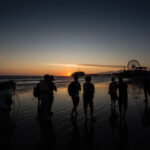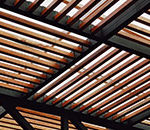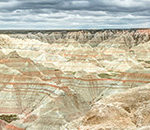Even when using proper exposure and camera settings, sometimes you may take a photo that you feel needs a little something extra. We always try to get it right in the camera, but sometimes you can’t avoid issues. Below, we’ll go through a few different scenarios you might come across in which you need to make an improvement that goes beyond basic level and curves corrections. Let’s get started.
Landscape Fix: Sky Replacement & Lens Flare

Keeping a stock collection of skies to use as replacements will make fixing photos such as this one much easier.
I liked the angle of the shot above, even though I’m shooting into the sun which put off a lens flare—we’ll need to remove that. Also, the sky is burned and distracting with the harsh sun. It’s a good idea to shoot some skies and build up your own sky collection so you can have a variety to choose from when you need to swap one out. Drag and drop your new sky into the image, placing the new sky below the background copy of the main image, like I’ve done below.
To select the old sky, I prefer to use the ‘Quick Selection’ and drag it through the sky. Press and hold the Shift key while clicking the areas between the fence posts to add them to your selection.
Tip: To select a straight line quickly just click at the beginning of a line (one of the fence posts for instance), hold down the Shift key, and click at the other end. This is faster and more accurate than dragging with your mouse along a line.

Don’t forget the small bits of sky that can be found in between areas such as the fence posts.
You don’t have to worry about getting the selection perfect; we’ll fine tune it later on. Invert the selection by navigating to the “Select” menu and clicking on “Inverse.” Now, add a layer mask to it. When tweaking the selection using the layer mask, paint with the brush tool using black to blend the new sky into the image areas you missed during the initial selection. Paint with white if you need to paint out the new sky, or you can paint in the new sky with an opacity of 50 percent or lower if you want to blend it with the existing sky. Paint with white if you need to paint out the new sky, or you can paint in the new sky with an opacity of 50 percent or lower if you want to blend it with the existing sky.

Paint on the layer mask to get the sky blended seamlessly.
In areas such as the fence posts in this image, you will need to zoom in to 200 percent to make certain that the sky is masked correctly.
Removing lens flare is a fairly easy task. I used the ‘Spot Healing Brush’ with the ‘Content Aware’ modifier selected. I painted over the flare and Photoshop did a good job cleaning it up. I then used the clone tool at 80 percent opacity to clone a few flowers into that area.

A quick once over with the clone tool made quick work of “erasing” the lens flare.
Tip: I very rarely use the clone tool at 100 percent opacity. It’s usually best to clone at a lower opacity to blend in what you are cloning. Make certain you take several different cloning samples of the area you are cloning from.
Next, add a ‘Curves Adjustment Layer’ to see if your image needs more light. I usually fill the mask with black and paint the light into the image where I want it.
If you have the Nik Color Efex plugin, you can use two filters I use on parts of some images—just be sure to use them sparingly. The first is ‘Contrast Color Range’. Move the ‘Color’ slider to get the color you want. I then select the ‘Brush’ option and brush in a little more color at low opacity, usually around 15 percent in some areas of the image. The second is ‘Tonal Contrast’. Once again, I brush it in at very low opacity’s, around 15 percent and only in areas I want to enhance and pop a little.

Use a High Pass Filter to help sharpen up your landscapes.
Finally, on all my landscape and architectural shots I use ‘High Pass Sharpening’ at a setting of 1.5 or 2.0; however, I never sharpen skies. Instead, add a layer mask and remove the sharpening from the sky. I may also reduce the sharpening from other areas, such as water.
House Fix: Fisheye Distortion, Sky Replacement & Severe Lens Flare

Here is the original photo before any edits were made to it.
Even with Photoshop’s ‘Lens Correction’ filter, and the new ‘Adaptive Wide Angle Filter’, I still find the ‘Fisheye-Hemi’ filter is the fastest way to go, with its one-click correction. If you have this filter, go ahead and apply this filter first.
Next, I replaced the sky using the same method we used in the first scenario; however, to remove the old sky from between trees and plants, select the ‘Background Eraser Tool’ and select the modifier ‘Sampling Once’ and ‘Contiguous’ options. I kept the ‘Tolerance’ at 50 percent.
Look at your layers palette to make sure you’re working on the image instead of the mask and zoom in to about 200 percent. Click into an area of old sky to get a sampling of what you want to remove and brush it away. I clicked on some off white areas and brushed them away as well.

Here, I am removing sections of clouds to clean up around the grassy area.
As we are erasing parts of the image, you may want to duplicate the masked layer first and turn it off. If you make a mistake and erase too much of the image, you can always go back in the History Palette to undo the erasure.
The healing tool will not work to remove the lens flare on this image because the flare is too large and there is not enough lawn to easily clone from to cover it up. What I did instead was to make a selection of part of the lawn using the Polygonal Lasso Tool. I then held down the Control/Command key and pressed ‘J” on my keyboard to place it on its own layer. I then duplicated that layer a few times.

The large lens flare in the bottom right corner is too large for the healing tool to properly repair.
With the Move Tool I arranged the different pieces of lawn to cover the lens flare. I erased unwanted edges by using the eraser tool with a soft brush before I merged the duplicated lawn layers into a single layer. Finally, I used the clone tool to clone parts of the new lawn, making it look natural and avoid a repeated pattern look.
We’ll use the same method to layer a clean portion of the fence over the smaller lens flare we see below.

The fence makes the smaller flare difficult to hide also, so we’ll use the same removal method as we used with the larger flare.
I zoomed into the area at 300 percent. I made a selection of the fence just to the right of the lens flare and copied it to its own layer. I then made another copy of it and moved these to start covering the lens flare.
This image was finished using the Nik Color Efex filters that were used in the first setting.

Here is what we have after all the corrections were applied.
Panorama Fix: Panoramic Misalignment
This image is a panorama made up of three vertical shots stitched in PTGui. Photoshop’s built-in stitcher is also very good, but for this image PTGui was better. However, it didn’t matter how much I worked the panorama—I could not get rid of the misalignment where the middle image joins the other two on the left and right.

Notice how the end of the wood boards do not line up?
To fix the wood cladding area at the top I made a large selection of the same wood areas in another photo of the house that I had shot at a similar angle.
I dragged it onto the panorama and applied the ‘Free Transform’ tool to size it so it covered the misalignment completely. I then made the new wood blend more smoothly by using the eraser tool with a soft brush and some cloning.
In the photo below, I have fixed the bottom of the window pane by making a selection of each of the three areas and applying the ‘Free Transform’ tool to the selection. I then dragged those areas so that they were close to lining up. I finished the fix by using the clone tool to repair any mismatched edges.
Interior Fisheye Correction: When Using a Fisheye Works
I use a fisheye sparingly, but sometimes it works well. I always shoot similar angles with my 14mm because the fisheye distortion–even after correction–does not always work best for the shot. But, this interior shot is a good example of when it does work. The owner of this house wanted to show as much of the interior arched ceiling as possible. The wider angle is much better than what I achieved with my 14 mm. To finish up this image, I used the Nik Tonal Contrast filter, which worked well at bringing out more detail in the brick ceiling.

For some interior shots a fisheye lens will be most advantageous.
As you can see, many of the techniques we learned can be applied in a variety of situations. By getting acquainted and comfortable with them, you can begin working them into your regular workflow.
About the Author:
Gavin Phillips founded Photographers Photoshop (http://photoeffects.biz/) over 15-years ago. Gavin came from a web design and teaching background. He loves teaching people software programs and creative techniques.
Like This Article?
Don't Miss The Next One!
Join over 100,000 photographers of all experience levels who receive our free photography tips and articles to stay current:













Sky in the first tut looks very unnatural in relation to the photograph, especially with the shadows of the clouds on the hills in the background.
Curious YOUR reasoning behind not sharpening the sky/water.
Thanks.
Lots of good information but incomplete instructions, hot detailed enough and assuming people know what you are thinking … tutorials are not easy to write.
Thanx Gavin for all of the juicy tidbits you shared with us here. Nicely written and easy to follow.